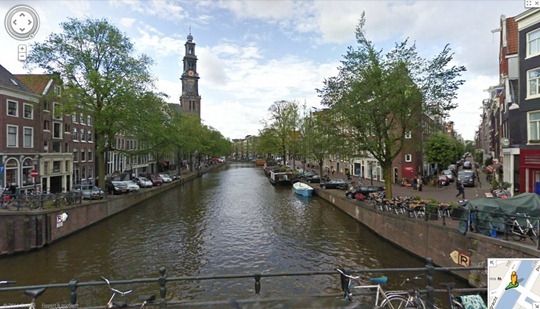
Photo Courtesy of Google Maps Street View (© Copyright)
The claim that no North American city could ever be Amsterdam is certainly true when it comes to history and architecture. But there is scant reasoning to conclude that North American cities couldn’t build Complete Streets modelled after Amsterdam.
Amsterdam Complete Streets are technically feasible in North America and could easily be done for a fraction of the cost we spend on building streets solely for motor vehicles.
Politically however, it is downright impossible for us to build Complete Streets comparable to Amsterdam’s. Societal, economic and environmental forces will change this, but for now we are nowhere near having the level of acceptance required to deliver true Complete Streets here.
The vast majority of streets in North American cities were designed primarily for private automobiles. When the baby boomers started driving in the 1960’s it created further demand for space so streets were widened primarily at the expense of pedestrian space.
There is nothing that makes Amsterdam physically unique that supports the argument that “it can only be done in Amsterdam” (political will and cultural differences aside).
We’ve heard all the excuses. The most common one I hear is that Amsterdam is old and the streets are narrow, so it is more conducive to bicycling. Except that there are plenty of narrow streets in North American cities, yet we still devote the vast majority of that space to motor vehicles.
And similarly, there are plenty of wide streets in Amsterdam – and that space is usually shared between all road users. Where Amsterdam could have fit 6 lanes of automobile traffic, they instead built 2 or 4 lanes of motor vehicle traffic, with wide sidewalks, separated bike lanes, and sometimes two lanes for transit vehicles.
Amsterdam has designed its streets for all people. People in Amsterdam drive cars, ride bikes, take transit and walk. In North America, we have designed our cities for car drivers only, not for all people.
As a result, driving is singularly viewed as the way to get around for all trips, and other modes of transportation are often inconvenient or uncomfortable because too many people drive private automobiles on roads with limited space.
The following photos courtesy of Google Maps with Street View illustrate how streets in Amsterdam are various shapes and sizes but share a common attribute of being inclusive for all people – irrespective of their mode of transportation – something we clearly lack in North America.
This street is currently under construction, but its temporary configuration features two lanes of motor vehicle lanes shared with transit vehicles, wide sidewalks and two bike lanes. You can see how the right bike lane continues behind the transit waiting area. In North America this would quite simply be four lanes of motor vehicle lanes – often with a much narrower sidewalk.
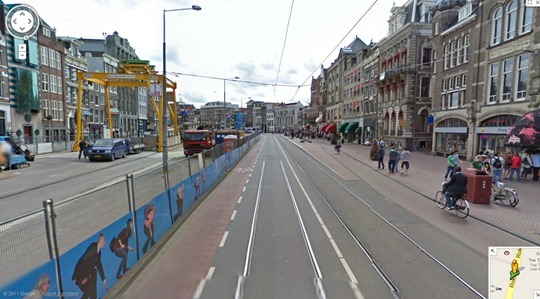
This street features one car lane, two bike lanes, two dedicated transit lanes, and four sidewalks. Once again, you can imagine how this same street would look in North America:
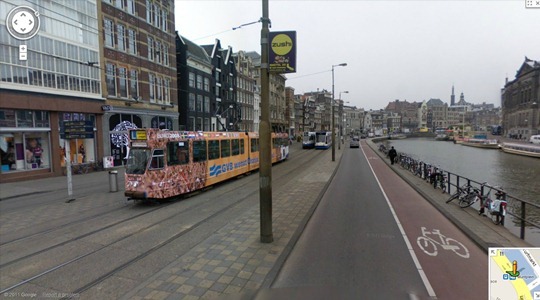
This narrower street features one car lane, two car parking lanes, two sidewalks and one bike lane:
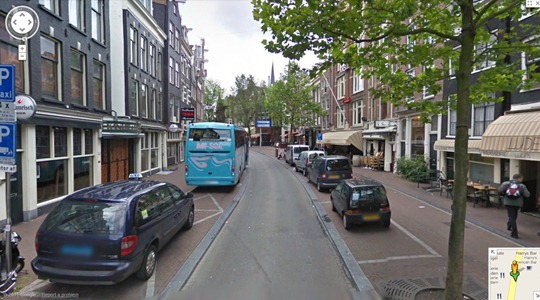
This street features one shared car/bike lane, one car parking lane, two wide sidewalks and bicycle parking stations:
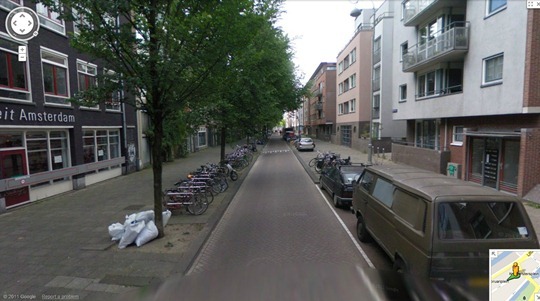
This narrow street features a narrow sidewalk, a very narrow car parking lane (with no guard rail to protect drivers from driving in the canal), and a shared car/bike lane:
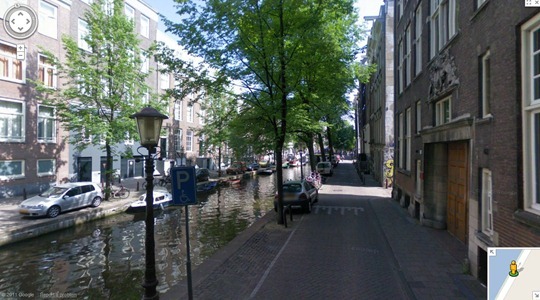
This wide street features two car lanes, one turning car lane, one car parking lane, one bicycle parking lane/sidewalk, three additional sidewalks, a protected bike lane on the left, and a shared car/bike lane on the right side (for local car traffic only & with a 30km/h speed limit).
In North America this would most likely be 5 car lanes plus car parking on each side with narrower sidewalks:
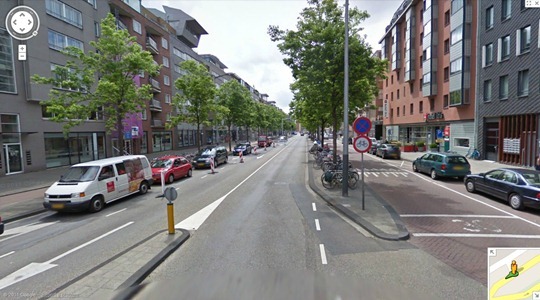
This wide street features two car lanes, two car parking lanes, two transit lanes, two bike lanes, and two sidewalks. Everyone gets an even piece of the pie on this “Complete Street”:
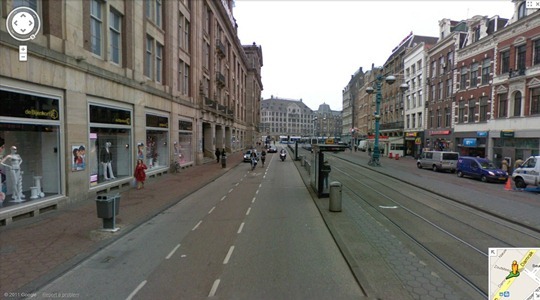
This wide street features vast public space for pedestrians, two bike lanes, one car lane and two dedicated transit lanes:
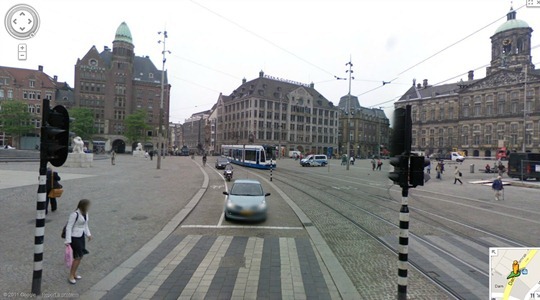
The last two photos are from outside of downtown (the ‘burbs). This particular street features just two lanes for cars, two very wide and protected bike lanes, and wide sidewalks:
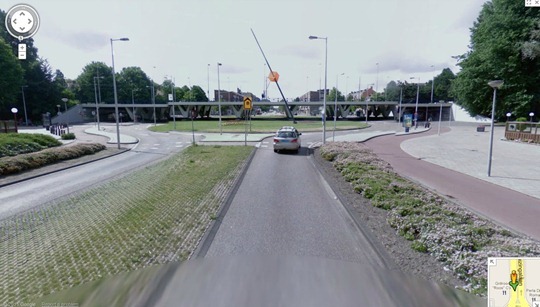
Also in the ‘burbs, this complete street features two main car lanes (with some additional turning lanes), two dedicated bike paths, and two sidewalks for pedestrians:
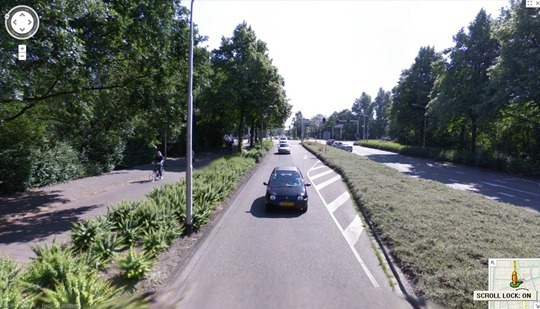
All Photos Courtesy of Google Maps Street View (© Copyright)
Clearly the design in Amsterdam was no accident. Amsterdam could have easily catered solely to motor vehicles like we have done in North America. But it knew better. It knew that the more roads it built, the more people would drive. It knew that if it gave its citizens no alternatives, they would have no choice but to drive.
By catering to people’s different transportation choices, the Netherlands has achieved what North America can only dream of: 26% of all journeys in the country are done by bicycle (2007 numbers provided by Fiets Beraad). In North America, roughly 1% of all trips are done by bicycle.
We clearly have a long way to go.
James D. Schwartz is a Transportation Pragmatist and the Editor of The Urban Country. You can contact James at james.schwartz@theurbancountry.com or follow him on Twitter.
Related Articles:
- Amsterdamizing The World (Jan 2011)
- Ghettoize Me, Please (Jan 2011)
- Copenhagenize Bicycle-Friendly Cities (Sept 2011)
- Bicycle Infrastructure Ignorance (Jan 2011)
- Making Sure Nobody Walks or Bikes (May 2011)



Don’t forget about the ‘boat lanes’, a.k.a. canals! 🙂
Don’t forget about the ‘boat lanes’, a.k.a. canals! 🙂
That looks really awesome. I like the idea of complete streets, but like you said, it is nearly impossible to muster the public will to get this done. Here in Kitchener-Waterloo, we have 1 ‘complete’ street, and it was received with mixed reviews. I personally like it, even though I mostly drive. It slows traffic, and it actually seems like there is more space.
PS I got my “I share the road” stickers yesterday. They look good.
That looks really awesome. I like the idea of complete streets, but like you said, it is nearly impossible to muster the public will to get this done. Here in Kitchener-Waterloo, we have 1 ‘complete’ street, and it was received with mixed reviews. I personally like it, even though I mostly drive. It slows traffic, and it actually seems like there is more space.
Ah…. Ah…. Thanks for posting this. It’s nice for bikers to read this, but I wonder if the “people in power” come to this site and read it.
Ah…. Ah…. Thanks for posting this. It’s nice for bikers to read this, but I wonder if the “people in power” come to this site and read it.
Heavenly.
Heavenly.
Pingback: Bicycle Transportation Should Be Taken Seriously ← The Urban Country
Pingback: The Parable Of The Bicycling Advocate… ← The Urban Country
Pingback: The Cost of Toronto’s First Cycle Track ← The Urban Country
Pingback: Free Parking? At What Cost? ← The Urban Country